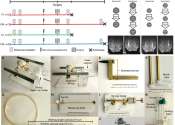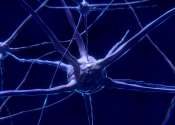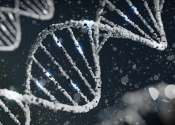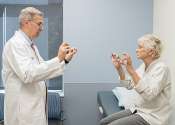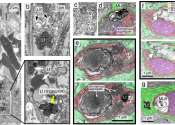Last update:
Parkinson's & Movement disorders news
Neuroscience
A newly-discovered mechanism could contribute to the therapeutic effects of deep brain stimulation
Deep brain stimulation (DBS) is a surgical procedure that entails the delivery of high-frequency electrical impulses to specific regions of the brain, via surgically implanted electrodes. While it requires an invasive surgical ...
7 hours ago
0
13
Parkinson's & Movement disorders
FDA-approved focused ultrasound treatment for essential tremor now in use as primary treatment for Parkinson's
Barely an hour after being wheeled into a clinical space at Oregon Health & Science University on Aug. 27, an Arkansas woman emerged with vastly improved symptoms of the Parkinson's disease that had plagued her for the past ...
3 hours ago
0
0
Q&A: New drug being reviewed by the FDA to treat Parkinson's disease
The U.S. Food and Drug Administration is reviewing a new Parkinson's disease drug called tavapadon that could give people with the disease more control over their movements.
5 hours ago
0
1

New rare genetic disease affecting motor neuron and muscle control identified
An international research team, led by Shinghua Ding at the University of Missouri, has identified a previously unknown genetic disease that affects movement and muscle control.
Oct 27, 2025
0
0

Why does ALS take away body movement? The hidden burden that seals the fate of motor neurons
ALS, also known as Lou Gehrig's disease, is among the most challenging neurological disorders: relentlessly progressive, universally fatal, and without a cure even after more than a century and a half of research. Despite ...
Oct 27, 2025
0
36

Blood immune cell analysis tested in patients shows promise for early Parkinson's detection
The genetic analysis of a blood sample could become a tool for the early diagnosis of Parkinson's disease, according to an exploratory study led by researchers from the Miguel Hernández University of Elche (UMH). Although ...
Oct 27, 2025
0
21

Advancement for people with Parkinson's in light therapy trial
Australian-founded medical technology company SYMBYX today announced compelling results from a 72-week randomized controlled trial (RCT) demonstrating improvements in a range of Parkinson's disease symptoms. These results, ...
Oct 23, 2025
0
0

Study unveils mechanisms driving axonal accumulation of TDP-43 and associated nerve damage in ALS
Amyotrophic lateral sclerosis (ALS) is a neurodegenerative disease characterized by progressive muscle wasting and limb paralysis. This neurodegenerative condition results from the gradual destruction of motor neurons, the ...

Women better protected against early neurodegeneration in Parkinson's disease, study reveals
A large international study involving nearly 700 participants reveals that women with a precursor condition to Parkinson's disease show significantly less brain atrophy—decreased cortical thickness in the brain—than men, ...
Oct 21, 2025
0
12

Study reveals Parkinson's protein clumps rob brain cells of vital energy
A new study led by Rice University's Pernilla Wittung-Stafshede has revealed that protein clumps, or plaques that clog the brain, associated with Parkinson's disease are not merely waste; they can actively drain energy from ...
Oct 21, 2025
0
22

Burden of pain significantly higher in Parkinson's patients
A major QIMR Berghofer-led study has found that Australians living with Parkinson's disease are nearly three times more likely to suffer from chronic pain compared to the general community, with two-thirds of patients experiencing ...
Oct 20, 2025
0
0

Simple blood test shows promise in detecting amyotrophic lateral sclerosis early
New research by UCLA Health has found a simple blood test could provide faster and more accurate diagnosis of ALS by measuring cell-free DNA. The noninvasive test could not only allow neurologists to rule out other neurological ...
Oct 16, 2025
0
10

How fruit flies can help us understand diseases such as ALS
If we can understand exactly how neurodegenerative diseases such as ALS progress in fruit flies, we may also gain valuable insights into how these diseases develop in humans. Research by neurobiologist Marije Been of Radboud ...
Oct 15, 2025
0
0

Receptor in cerebellum provides new insights into molecular basis of ataxia
Researchers at Ruhr University Bochum, Germany, identified a receptor that plays a crucial role in stress-induced motor incoordination associated with ataxias. These hereditary motor disorders have long been linked to the ...
Oct 10, 2025
0
0

Restless leg syndrome's connection to Parkinson's disease
Three research hospitals in the Republic of Korea are reporting that restless leg syndrome was associated with an increased risk of Parkinson's disease, with 1.6% of patients with restless leg syndrome developing Parkinson's ...

Study reveals genetic link between childhood brain disorder and Parkinson's disease in adults
Errors in a gene known to cause a serious neurodevelopmental condition in infants are also linked to the development of Parkinson's disease in adolescence and adulthood, according to new research.
Oct 8, 2025
0
0

More than motor skills: Study of cognitive and psychological symptoms of Parkinson's
Cognitive decline and anxiety in Parkinson's disease are often only recognized at a late stage, yet they can greatly impact people's lives. Research by Marit Ruitenberg focuses on new tests and methods to improve early identification ...
Oct 7, 2025
0
0

Newly discovered key switch for cellular energy balance could pave way for Parkinson's disease therapies
A key switch for cellular energy balance has been discovered in cells, and it could potentially become the target of new therapies for diseases ranging from Parkinson's to rare disorders caused by defects in mitochondria.
Oct 3, 2025
0
50

Cerebellum found to contribute to symptoms in spinal muscular atrophy
Spinal muscular atrophy affects all the body's muscles. For a long time, it was considered a disease caused solely by the loss of nerve cells in the spinal cord. Now, a research team at Leipzig University's Carl Ludwig Institute ...
Oct 2, 2025
0
0

Parkinson's 'trigger' directly observed in human brain tissue for the first time
Scientists have, for the first time, directly visualized and quantified the protein clusters believed to trigger Parkinson's, marking a major advance in the study of the world's fastest-growing neurological disease.
Oct 1, 2025
0
134

Scientists design peptide 'switch' that keeps Parkinson's protein in its healthy form
Researchers at the University of Bath, in collaboration with the Universities of Oxford and Bristol, have developed a molecule that prevents the clumping and build-up of a protein linked to Parkinson's disease and related ...
Oct 1, 2025
0
48

Outdoor air exposure to industrial solvent trichloroethylene may raise risk of Parkinson's disease
Long-term exposure to the industrial solvent trichloroethylene (TCE) outdoors may be linked to an increased risk of Parkinson's disease, according to a large nationwide study published in Neurology.
Oct 1, 2025
0
26

ALS appears to be an autoimmune disease as immune cells attack nervous system proteins
Around 5,000 Americans are diagnosed with amyotrophic lateral sclerosis (ALS) each year. About half of patients die within 14 to 18 months of being diagnosed, usually due to breathing failure. The exact cause of ALS has long ...
Oct 1, 2025
0
35

Huntingtin protein arranges cytoskeletal filaments, offering insight into neurodegeneration
Huntington's disease is a rare genetic disorder and a representative neurodegenerative disease, characterized by loss of motor control, cognitive decline, and psychiatric problems. An international research team has discovered ...
Oct 1, 2025
0
22

Q&A: Is the medical community on the brink of a cure for Huntington's disease?
Huntington's disease is a fatal, hereditary neurological disorder mostly striking people between the ages of 30 and 50.
Sep 30, 2025
0
0





















